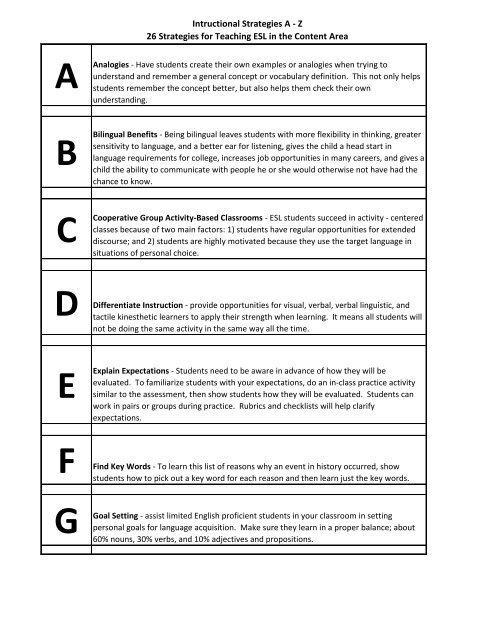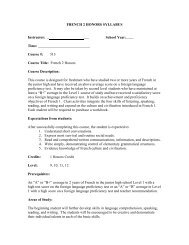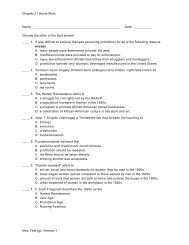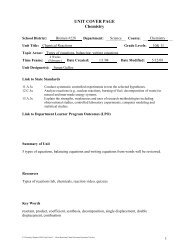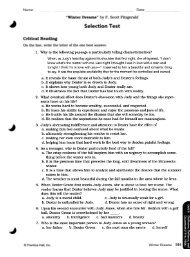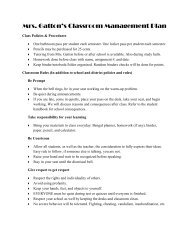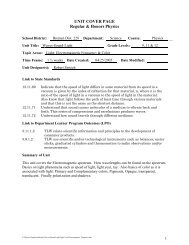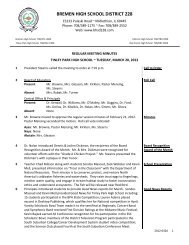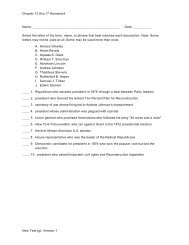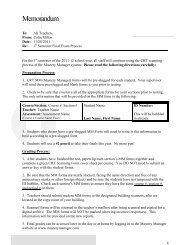Intructional Strategies A - Z 26 Strategies for Teaching ESL in the ...
Intructional Strategies A - Z 26 Strategies for Teaching ESL in the ...
Intructional Strategies A - Z 26 Strategies for Teaching ESL in the ...
You also want an ePaper? Increase the reach of your titles
YUMPU automatically turns print PDFs into web optimized ePapers that Google loves.
<strong>Intructional</strong> <strong>Strategies</strong> A - Z<strong>26</strong> <strong>Strategies</strong> <strong>for</strong> <strong>Teach<strong>in</strong>g</strong> <strong>ESL</strong> <strong>in</strong> <strong>the</strong> Content AreaAAnalogies- Have students create <strong>the</strong>ir own examples or analogies when try<strong>in</strong>g tounderstand and remember a general concept or vocabulary def<strong>in</strong>ition. This not only helpsstudents remember <strong>the</strong> concept better, but also helps <strong>the</strong>m check <strong>the</strong>ir ownunderstand<strong>in</strong>g.BBil<strong>in</strong>gualBenefits - Be<strong>in</strong>g bil<strong>in</strong>gual leaves students with more flexibility <strong>in</strong> th<strong>in</strong>k<strong>in</strong>g, greatersensitivity to language, and a better ear <strong>for</strong> listen<strong>in</strong>g, gives <strong>the</strong> child a head start <strong>in</strong>language requirements <strong>for</strong> college, <strong>in</strong>creases job opportunities <strong>in</strong> many careers, and gives achild <strong>the</strong> ability to communicate with people he or she would o<strong>the</strong>rwise not have had <strong>the</strong>chance to know.CCooperativeGroup Activity-Based Classrooms - <strong>ESL</strong> students succeed <strong>in</strong> activity - centeredclasses because of two ma<strong>in</strong> factors: 1) students have regular opportunities <strong>for</strong> extendeddiscourse; and 2) students are highly motivated because <strong>the</strong>y use <strong>the</strong> target language <strong>in</strong>situations of personal choice.DDifferentiateInstruction - provide opportunities <strong>for</strong> visual, verbal, verbal l<strong>in</strong>guistic, andtactile k<strong>in</strong>es<strong>the</strong>tic learners to apply <strong>the</strong>ir strength when learn<strong>in</strong>g. It means all students willnot be do<strong>in</strong>g <strong>the</strong> same activity <strong>in</strong> <strong>the</strong> same way all <strong>the</strong> time.EExpla<strong>in</strong>Expectations - Students need to be aware <strong>in</strong> advance of how <strong>the</strong>y will beevaluated. To familiarize students with your expectations, do an <strong>in</strong>-class practice activitysimilar to <strong>the</strong> assessment, <strong>the</strong>n show students how <strong>the</strong>y will be evaluated. Students canwork <strong>in</strong> pairs or groups dur<strong>in</strong>g practice. Rubrics and checklists will help clarifyexpectations.FF<strong>in</strong>dKey Words - To learn this list of reasons why an event <strong>in</strong> history occurred, showstudents how to pick out a key word <strong>for</strong> each reason and <strong>the</strong>n learn just <strong>the</strong> key words.GGoalSett<strong>in</strong>g - assist limited English proficient students <strong>in</strong> your classroom <strong>in</strong> sett<strong>in</strong>gpersonal goals <strong>for</strong> language acquisition. Make sure <strong>the</strong>y learn <strong>in</strong> a proper balance; about60% nouns, 30% verbs, and 10% adjectives and propositions.
<strong>Intructional</strong> <strong>Strategies</strong> A - Z<strong>26</strong> <strong>Strategies</strong> <strong>for</strong> <strong>Teach<strong>in</strong>g</strong> <strong>ESL</strong> <strong>in</strong> <strong>the</strong> Content AreaHHonor<strong>the</strong> Student's Native Language - Encourage English speak<strong>in</strong>g while re<strong>in</strong><strong>for</strong>c<strong>in</strong>g <strong>the</strong>value of <strong>the</strong> learner's native tongue. Never let <strong>the</strong> student feel ashamed of his or hernative language or culture, and model that respect <strong>for</strong> your students.IJKKnowIntegrate Instruction - <strong>in</strong>tegrated learn<strong>in</strong>g is beneficial <strong>for</strong> all students, especially <strong>ESL</strong>learners. The ability to connect learn<strong>in</strong>g <strong>in</strong> one subject area to learn<strong>in</strong>g <strong>in</strong> ano<strong>the</strong>r<strong>in</strong>creases retention by <strong>in</strong>creas<strong>in</strong>g transfer.Justify Why, How and When - Show your students <strong>the</strong> 'how', 'when', and 'why' to uselanguage learn<strong>in</strong>g strategies, and to evaluate and monitor <strong>the</strong>ir own learn<strong>in</strong>g. - Previewteach<strong>in</strong>g material and activities to identify strategies <strong>for</strong> <strong>in</strong>struction. - Present strategy bynam<strong>in</strong>g it and expla<strong>in</strong><strong>in</strong>g when and why to use it - Model <strong>the</strong> strategy, provideopportunities to practice <strong>the</strong> stratgy with various activities/tasks - Develop students' abilityto evaluate strategy. Develop skills to transfer strategy use to new tasks ( Adapted fromScope and Sequence Frameworks <strong>for</strong> Learn<strong>in</strong>g Strategy Instruction <strong>in</strong> O'Malley & Charmot,1995, pp. 158-9)Students' Learn<strong>in</strong>g Styles - use a learn<strong>in</strong>g styles <strong>in</strong>ventory or observation to discover<strong>the</strong> learn<strong>in</strong>g style or multiple <strong>in</strong>telligence <strong>in</strong> which each student has a dom<strong>in</strong>ant strength.Use that knowledge to prescribe <strong>the</strong> best learn<strong>in</strong>g options <strong>for</strong> <strong>the</strong> student; and let studentsknow <strong>the</strong> results so <strong>the</strong>y will know <strong>the</strong> best ways <strong>for</strong> <strong>the</strong>m to study.LLearnMMemoryTheir Language - Students will relax and feel com<strong>for</strong>table <strong>in</strong> your classroom if youmake an ef<strong>for</strong>t to learn <strong>the</strong>ir vocabulary. Simply ask<strong>in</strong>g <strong>ESL</strong> students to say words orphrases <strong>in</strong> <strong>the</strong>ir native tongue can <strong>in</strong>crease trust and empathy on both sides.Techniques - Have students learn how to group items <strong>in</strong>to categories <strong>in</strong> order tomemorize <strong>the</strong>m. If <strong>the</strong>y have a long list of th<strong>in</strong>gs to memorize, show <strong>the</strong>m how to groupsimilar items toge<strong>the</strong>r or to use anagrams <strong>for</strong> memory recall.NNoBusy Work - Set reasonable goals <strong>for</strong> <strong>the</strong> material your English Language Learnersshould be responsible <strong>for</strong>. Be sure it is relevant. Adapt tests if necessary to fairly assesswhat your students should be able to do. There is no po<strong>in</strong>t <strong>in</strong> <strong>the</strong>ir memoriz<strong>in</strong>g a list ofspell<strong>in</strong>g words, <strong>for</strong> example, if <strong>the</strong>y do not understand what <strong>the</strong> words mean.
<strong>Intructional</strong> <strong>Strategies</strong> A - Z<strong>26</strong> <strong>Strategies</strong> <strong>for</strong> <strong>Teach<strong>in</strong>g</strong> <strong>ESL</strong> <strong>in</strong> <strong>the</strong> Content AreaOOralPPromoteQQuitSummaries, Outl<strong>in</strong>es, Ven Diagrams, and M<strong>in</strong>d Maps - Should be used to assist <strong>ESL</strong>learners. Teachers should try to use visual reviews with lists and charts; paraphrase <strong>the</strong>salient po<strong>in</strong>ts where appropriate; and have students provide oral summaries <strong>the</strong>mselves.and Practice <strong>the</strong> Power of Patterns - know <strong>the</strong> basic language patterns <strong>for</strong> <strong>the</strong>second language and know how <strong>the</strong>y compare to English patterns. Give studentsopportunities to recognize and practice patterns.Talk<strong>in</strong>g So Much - <strong>ESL</strong> learners improve <strong>the</strong>ir fluency when <strong>the</strong>y have opportunitiesto speak. Pair and share activities after a brief teacher talk will help <strong>ESL</strong> learners to check<strong>the</strong>ir comprehension with a buddy.RRetroactivityand Repetition - Use both to <strong>in</strong>crease language proficiency. Repetition ishow many times you repeat someth<strong>in</strong>g <strong>in</strong> a given time period, retroactivity is how long youuse and apply it from when you <strong>in</strong>itially learned it. Return to vocabulary from previousunits and give students a chance to apply those terms <strong>in</strong> a new <strong>in</strong>structional topic. Just like<strong>in</strong> physical exercise, <strong>the</strong> number of repetitions and <strong>the</strong> retroactivity <strong>in</strong>crease strength.SSixFacts of Understand<strong>in</strong>g - In order <strong>for</strong> learners to deeply understand a topic, it must beexperienced from all six facets. Learners should be able to Expla<strong>in</strong>, Apply, Interpret, andalso ga<strong>in</strong> Empathy, Perspective and Self-Knowledge.TTh<strong>in</strong>kAloud - Use "th<strong>in</strong>k-out-loud" model<strong>in</strong>g. " Listen to me th<strong>in</strong>k out loud". Take a "tour"of a read<strong>in</strong>g selection show<strong>in</strong>g students how you scan <strong>the</strong> text first look<strong>in</strong>g at pictures,graphics, and titles. Share <strong>the</strong> questions you have about <strong>the</strong> text be<strong>for</strong>e you beg<strong>in</strong> read<strong>in</strong>g.UUseVisuals and Graphic Organizers - to support <strong>ESL</strong> students' ef<strong>for</strong>ts at read<strong>in</strong>g lengthysections of text, graphic organizers can aid <strong>in</strong> identify<strong>in</strong>g <strong>the</strong> important im<strong>for</strong>mation youwant <strong>the</strong>m to f<strong>in</strong>d. Break lengthy sections down and have student group discussionsbetween <strong>the</strong> shorter text segments. Teach students to visialize what <strong>the</strong>y're try<strong>in</strong>g tolearn. Have <strong>the</strong>m create a mental image or organize <strong>in</strong><strong>for</strong>mation on a graphic organizer.
VValue<strong>Intructional</strong> <strong>Strategies</strong> A - Z<strong>26</strong> <strong>Strategies</strong> <strong>for</strong> <strong>Teach<strong>in</strong>g</strong> <strong>ESL</strong> <strong>in</strong> <strong>the</strong> Content AreaDiverisity - demonstrate an <strong>in</strong>terest <strong>in</strong> and support of students whose backgrounddiffers from your own. Know <strong>the</strong> strengths that accept<strong>in</strong>g diversity has to offer us as anation. Share those benefits with your students.WWrittenCompositions - allow students to write a first draft <strong>in</strong> <strong>the</strong>ir native tongue to get afluency and cohesiveness of ideas. While o<strong>the</strong>r students are revis<strong>in</strong>g and edit<strong>in</strong>g, <strong>ESL</strong>students can translate <strong>in</strong>to English. Babelfish is a good onl<strong>in</strong>e resource to assist students <strong>in</strong>translat<strong>in</strong>g http://babelfish.altavista.com/babelfish/trXXperiment (Encourage Experimentation) - a child needs to experiment and produceutterances that may be <strong>in</strong>accurate yet reflect normal language development. In this way,<strong>the</strong> child is attempt<strong>in</strong>g to figure out <strong>the</strong> patterns and rules that govern <strong>the</strong> language. Tocorrect <strong>the</strong> child's speech, grammar or spell<strong>in</strong>g, teachers should rephrase or expand onwhat <strong>the</strong> child has already said or written. Feedback from peers will also help <strong>the</strong> childrendeterm<strong>in</strong>e correct from <strong>in</strong>correct ways of communicat<strong>in</strong>g. They test <strong>the</strong>se chunks oflanguage by us<strong>in</strong>g <strong>the</strong>m <strong>in</strong> situations that may or may not be appropriate. The feedback<strong>the</strong>y receive helps <strong>the</strong>m determ<strong>in</strong>e whe<strong>the</strong>r <strong>the</strong>y have guessed correctly. Positivefeedback works best.YYouthRole Models - For each subpopulation, know <strong>the</strong> leaders <strong>in</strong> your community thathave been successful transition<strong>in</strong>g <strong>in</strong>to <strong>the</strong> American culture speak<strong>in</strong>g English. Involve<strong>the</strong>m <strong>in</strong> your classroom <strong>for</strong> <strong>the</strong> benefit of all students. Students older, but closer to <strong>the</strong>irage will have a greater impact. high school students could visit elementary classrooms asrole models, and college students or graduates can greatly impact current High schoolstudents.ZZeal<strong>for</strong> Higher Order Th<strong>in</strong>k<strong>in</strong>g - Teachers must create opportunities to focus on th<strong>in</strong>k<strong>in</strong>gskills <strong>in</strong>clud<strong>in</strong>g predict<strong>in</strong>g, categoriz<strong>in</strong>g, generaliz<strong>in</strong>g and mak<strong>in</strong>g <strong>in</strong>ferences which are easliyaddressed <strong>in</strong> <strong>the</strong> warm-up and motivation phases of a lesson; observ<strong>in</strong>g, report<strong>in</strong>g andclassify<strong>in</strong>g, which can be done orally, <strong>in</strong> writ<strong>in</strong>g or pictorially, and which fit nicely <strong>in</strong>topresentation and application phases; and sequenc<strong>in</strong>g, summariz<strong>in</strong>g and justify<strong>in</strong>g, which fitwell <strong>in</strong> lesson reviews. (adapted from How to Integrate Language and Content Instruction,Center <strong>for</strong> Applied L<strong>in</strong>guistics, 1191 by Deborah J. Short)


